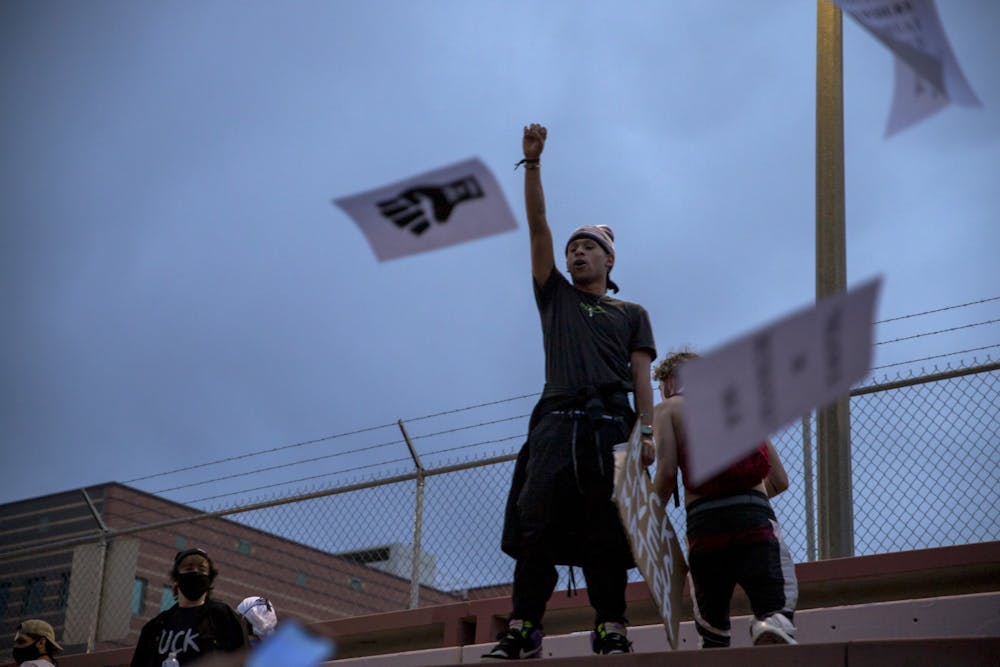Since George Floyd’s murder at the hands of a white Minneapolis police officer on May 25, Black Lives Matter (BLM) protests have been revived across the nation to advocate for racial equity and an end to police brutality.
In addition to voicing their opposition on the streets, individuals of all ages and races are utilizing social media as a platform to educate their followers and publicize their opinions.
African American Student Services (AASS) representative Dannelle Kirven said social media can be a vehicle for social justice due to its capacity to efficiently share information.
“There are several posts being shared on Facebook, Instagram, Twitter, etc., telling people exactly what they can do to show support and uplift the Black community, from supporting Black-owned businesses in their area to providing numbers to dial to demand justice for those who have been victims of police brutality,” Kirven said.
AASS senior student success specialist Johana Gourdin said while social media is overall a successful educational aid for those learning to think critically about race and social justice, it runs the risk of limiting the involvement of activists.
“There are plenty of other ways to get involved: petitions, donations, volunteering, making educational graphics, reviewing policies and laws, voting and most importantly self-reflection,” Gourdin said.
Gourdin also said the most difficult yet crucial task is to think critically about one’s own complicity toward or benefit from the oppression of others. She said these bystander behaviors affect all individuals — even the well-intentioned ones — but “now is the time to be better.”
Hand-in-hand with complicity is performative activism, which has been pervasive on social media platforms.
For example, posting black squares on Blackout Tuesday elicited backlash because many considered the act a hollow demonstration of support. Kirven said the gesture should be accompanied by an acknowledgement of past infractions and a promise to improve.
“There are several institutions, organizations and individuals who posted a black square for Blackout Tuesday that have participated in racist behavior or stood silent on issues of racial injustice until now,” Kirven said. “If you stand with the message then go ahead and make your post, but also make a post that says that you have been a part of this problem and are taking the necessary steps to make a change within your system.”
Gourdin compared the black square posts to jumping on an internet bandwagon and said to research the BLM movement in addition to simply posting.
“If anyone posted that square and thought their work for racial justice was done, they were wrong,” Gourdin said. “Do your research and learn about the movement before taking uninformed action, because your vigor can be a distraction, or worse, a detriment.”
Get content from The Daily Lobo delivered to your inbox
Others are using social media to mass distribute photographic evidence of police brutality. These images depict injuries or even killings of protesters or members of the Black community perpetrated by police.
Gourdin said the videos can be desensitizing but need to be seen by allies — especially because the content is not not new to Black viewers.
“I know what it is to watch a Black man die in the street, to see the street fill with protesters for a while, to see the street return to 'normal' until it happens again,” Gourdin said. “But I do believe it is the responsibility of allies to see it, to hold themselves accountable to changing the spaces they have privilege, to concretely remember why we must change. I already know why: I live it.”
Kirven said respect for the family of individuals depicted in the graphic distributions must take priority, but the images and videos nonetheless need visibility.
“An individual who is uncomfortable about seeing police attack and murder Black people on their timeline should take a step back and think about how dehumanizing it is to be treated a certain way by law enforcement and live in a different reality in regard to the police,” Kirven said. “Being desensitized to the content just might be a part of another individual’s privilege.”
Yet, both Kirven and Gourdin see hope for the future.
“Our state prides itself on being diverse, but the truth is the Black New Mexican population across the state deserves more, and based on all the statements on diversity and inclusivity, that’s exactly what we are expecting,” Kirven said.
Gourdin echoed Kirven’s sentiments and advised activists to take time to rest.
“Take breaks from reading especially heavy texts, don't take in too many police brutality videos at once, get comfortable deciphering statistics, do not rely on Black people to do the emotional labor for you, do not take one action and forget the why and DO be kind to yourself — you are helping create a better world,” Gourdin said.
Beatrice Nisoli is a senior reporter at the Daily Lobo. She can be contacted at culture@dailylobo.com or on Twitter @BeatriceNisoli






